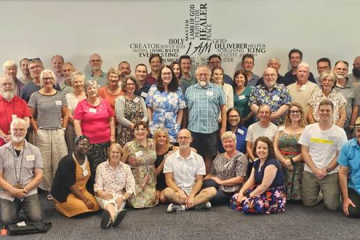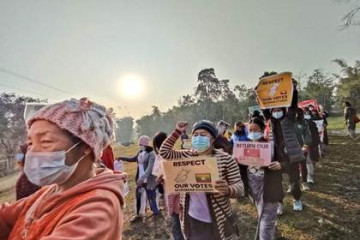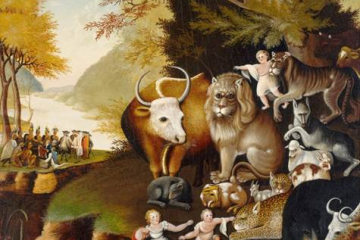Reading Exodus 12:1-14 (NRSV)
Background
During most of the last 3 months we followed the O.T. lectionary readings in Genesis. We have looked at key events in the lives of 4 generations – Abraham and Sarah; their son Isaac and his wife Rebekah; then Jacob (or Israel to give him his later name) and Rachel; and most recently, Joseph and his brothers.
Joseph died in Egypt where he had been Pharaoh’s second-in-charge. Before he died, he was able to settle his father and brothers and relatives in Egypt and look after them. With the passing of this and successive generations, the Egyptians enslaved the Hebrew people. This is the situation at the beginning of the next book in the Bible – Exodus, which means exit or departure, which sounds promising, but that’s jumping ahead.
In the early chapters of Exodus, we read how God raised up and called Moses to set the people free. You know the story, how Moses tries to get Pharaoh to let them go. Pharaoh refuses time after time, even though God sends a plague of one sort or another after each refusal. Finally, Moses warns Pharaoh that there will be a 10th plague, a final one. As God passes through the land all the first-born children and animals of Egypt will die but God will pass over and spare the Hebrews.
Today’s Reading
That’s where today’s reading comes in. It comes right as the drama is building to a climax. There’s this rather long pause before the action resumes. But it’s a very important pause. God takes the time to give instructions about what is going to happen and what the people need to do to escape. There are a few crucial instructions.
- The primary one is that each family is to kill a lamb and put the blood around the outside of their door. God would pass over their homes and they would escape death.
- They are also told that each family is to have a meal of the lamb roasted over fire with unleavened bread and bitter herbs (v8). Their escape into the desert would be arduous and they would need such a meal beforehand. They would have to leave quickly, hence the unleavened bread. There would be no time to wait for bread in it to rise.
- God’s instructions go beyond the immediate situation. They are to have a yearly festival to celebrate and remember their deliverance.
“This day shall be a day of remembrance for you. You shall celebrate it as a festival to the LORD; throughout your generations you shall observe it as a perpetual ordinance.” (v14)
Passover Meal
In the spirit of this instruction, Jews have continued to celebrate the Passover ever since. A family Seder meal at Passover is a highly significant religious and cultural event. It is a meal that includes various ritual or symbolic items of food.

A Seder plate usually have the following.
- A roasted lamb shank – a reminder of the lambs on that first Passover night.
- A roasted egg – represents hardness and is a reminder of festival sacrifice in the Jerusalem Temple in the past.
3,4. Horseradish and onion – the bitter herbs.
- Charoset – a sweet salad of apples, nuts, wine and cinnamon said to
represent the mortar used by the Hebrew slaves to make bricks.
- Parsley – symbolic of freshness and spring.
3 or sometimes 4 pieces of unleavened bread are placed in a pile on a separate plate.
4 small cups of wine are usually drunk, like toasts, during different parts of the meal. There is 1 for each of the 4 expressions of redemption God uses in describing their deliverance from Egypt –
- I will take you out…
- I will save you…
- I will redeem you…
- I will take you as a nation…
Questions and answers or explanations are another feature of the Seder ritual. A child usually asks the questions, beginning with the famous one: “Why is this night from other nights?”
Questions about the significance of the various food items on the table are also asked and answered.
The Last Supper
It is generally understood that the Last Supper that Jesus had with his disciples was a Passover meal, though obviously not with all the modern refinements.
During the meal when it came time to explain the significance of the bread, Jesus looked ahead and said it represented his body that would be given for them. He told them to remember him when they ate.
The Bible explicitly draws the parallel between the sacrifice of Passover lambs and the sacrifice of Jesus, the Lamb of God, on the cross.
When it came time to explain the significance of the wine, Jesus said it represented his blood poured out for the forgiveness of others. He said to remember him when they drank.
By the way, did you know that Matthew and Mark in their accounts of the Last Supper have the eating of the bread first and then the drinking of the wine. Luke however has the cup first, then the bread… then the cup again. He’s not wrong, just more detailed, and mentions one of the other Passover cups that Matthew and Mark don’t.
Communion
The Early Church quickly adopted the practice of remembering Jesus’ death through frequent memorial meals, not just once per year like the Passover. Initially such meals were in homes in extended family groups but developed to be whole church events called “agape meals” or love feasts. Paul gives lots of instructions about these in Corinthians.
Later still, for various theological and practical reasons, more ritualised and symbolic memorials occurred in church services. Around Easter though many churches have a meal that is more like a Passover meal.
Having described the development of Passover and Communion traditions, at least in a rudimentary way, I’d like to offer 2 reflections.
- The first is about transformation.
God is a God who transforms, even when transformation seems impossible. The Hebrews had been in bondage in Egypt for some 400 years. But God delivered them – transformned from being slaves to being free. They had a tragic past and miserable present but now they had a promising future.
So significant was this even that God even transformed their calendar.
12:2. “This month shall mark for you the beginning of months; it shall be the first month of the year for you.”
A bit like the coming of Jesus transformed the calendar into Before Christ and After Christ.
Jesus came on the Father’s mission of transformation – a mission to set captives free and to release the oppressed. Our lives can be transformed for the better by God, because God is a God who transforms. He raised Jesus from death to life, and we are raised from death to life in him.
We get a new calendar too – an eternal one.
- My second reflection is on the nature of family.
The Passover in today’s Exodus reading was to be observed in distinct family groupings. This is still the basis of Jewish Passover celebrations today, though non-family members are often included.
In the Early Church and the Church today, Communion or Eucharist is not a nuclear family celebration. It is a celebration of the Church, the family of God. Through faith we are part of a new family – sisters and brothers in Christ. This family is not limited to one race but encompasses people from all nations of the world. The Exodus of the Hebrews from slavery in Egypt was the forerunner to a much greater Exodus – the Exodus of people from all nations from slavery to the bondage of sin. The only begotten Son of God died so that we might be part of his family.
That’s worth remembering and celebrating.
We are going to do that now as we move into our time of Communion.
The choir is going to sing “Agnus Dei”, “Lamb of God”.


